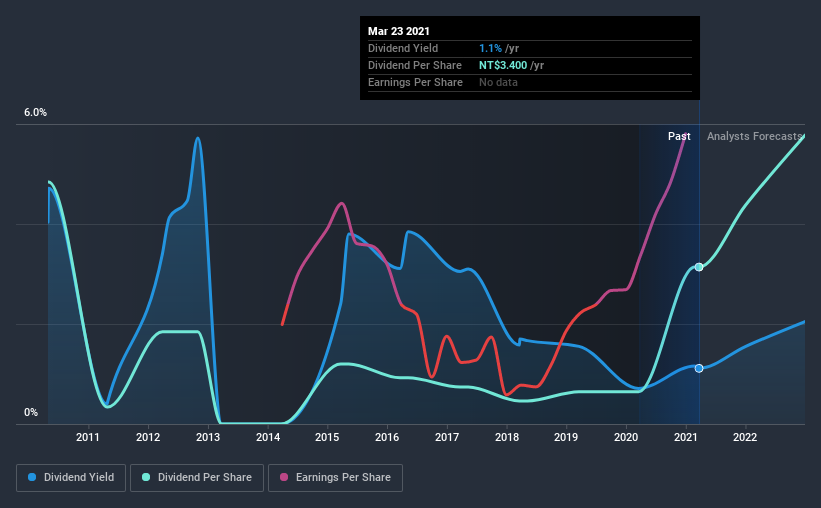- Taiwan
- /
- Electronic Equipment and Components
- /
- TWSE:8046
Is Nan Ya Printed Circuit Board Corporation (TPE:8046) A Good Fit For Your Dividend Portfolio?

Is Nan Ya Printed Circuit Board Corporation (TPE:8046) a good dividend stock? How can we tell? Dividend paying companies with growing earnings can be highly rewarding in the long term. On the other hand, investors have been known to buy a stock because of its yield, and then lose money if the company's dividend doesn't live up to expectations.
A slim 1.1% yield is hard to get excited about, but the long payment history is respectable. At the right price, or with strong growth opportunities, Nan Ya Printed Circuit Board could have potential. Remember though, due to the recent spike in its share price, Nan Ya Printed Circuit Board's yield will look lower, even though the market may now be factoring in an improvement in its long-term prospects. Some simple research can reduce the risk of buying Nan Ya Printed Circuit Board for its dividend - read on to learn more.
Explore this interactive chart for our latest analysis on Nan Ya Printed Circuit Board!

Payout ratios
Companies (usually) pay dividends out of their earnings. If a company is paying more than it earns, the dividend might have to be cut. Comparing dividend payments to a company's net profit after tax is a simple way of reality-checking whether a dividend is sustainable. Looking at the data, we can see that 60% of Nan Ya Printed Circuit Board's profits were paid out as dividends in the last 12 months. This is a healthy payout ratio, and while it does limit the amount of earnings that can be reinvested in the business, there is also some room to lift the payout ratio over time.
We also measure dividends paid against a company's levered free cash flow, to see if enough cash was generated to cover the dividend. Last year, Nan Ya Printed Circuit Board paid a dividend while reporting negative free cash flow. While there may be an explanation, we think this behaviour is generally not sustainable.
With a strong net cash balance, Nan Ya Printed Circuit Board investors may not have much to worry about in the near term from a dividend perspective.
Remember, you can always get a snapshot of Nan Ya Printed Circuit Board's latest financial position, by checking our visualisation of its financial health.
Dividend Volatility
Before buying a stock for its income, we want to see if the dividends have been stable in the past, and if the company has a track record of maintaining its dividend. For the purpose of this article, we only scrutinise the last decade of Nan Ya Printed Circuit Board's dividend payments. The dividend has been cut on at least one occasion historically. During the past 10-year period, the first annual payment was NT$5.2 in 2011, compared to NT$3.4 last year. The dividend has shrunk at around 4.2% a year during that period. Nan Ya Printed Circuit Board's dividend has been cut sharply at least once, so it hasn't fallen by 4.2% every year, but this is a decent approximation of the long term change.
When a company's per-share dividend falls we question if this reflects poorly on either external business conditions, or the company's capital allocation decisions. Either way, we find it hard to get excited about a company with a declining dividend.
Dividend Growth Potential
With a relatively unstable dividend, it's even more important to evaluate if earnings per share (EPS) are growing - it's not worth taking the risk on a dividend getting cut, unless you might be rewarded with larger dividends in future. It's good to see Nan Ya Printed Circuit Board has been growing its earnings per share at 34% a year over the past five years. Earnings per share are sharply up, but we wonder if paying out more than half its earnings (leaving less for reinvestment) is an implicit signal that Nan Ya Printed Circuit Board's growth will be slower in the future.
Conclusion
When we look at a dividend stock, we need to form a judgement on whether the dividend will grow, if the company is able to maintain it in a wide range of economic circumstances, and if the dividend payout is sustainable. First, the company has a payout ratio that was within an average range for most dividend stocks, but it paid out virtually all of its generated cash flow. Next, earnings growth has been good, but unfortunately the dividend has been cut at least once in the past. Ultimately, Nan Ya Printed Circuit Board comes up short on our dividend analysis. It's not that we think it is a bad company - just that there are likely more appealing dividend prospects out there on this analysis.
Investors generally tend to favour companies with a consistent, stable dividend policy as opposed to those operating an irregular one. At the same time, there are other factors our readers should be conscious of before pouring capital into a stock. For example, we've picked out 1 warning sign for Nan Ya Printed Circuit Board that investors should know about before committing capital to this stock.
Looking for more high-yielding dividend ideas? Try our curated list of dividend stocks with a yield above 3%.
If you decide to trade Nan Ya Printed Circuit Board, use the lowest-cost* platform that is rated #1 Overall by Barron’s, Interactive Brokers. Trade stocks, options, futures, forex, bonds and funds on 135 markets, all from a single integrated account. Promoted
Valuation is complex, but we're here to simplify it.
Discover if Nan Ya Printed Circuit Board might be undervalued or overvalued with our detailed analysis, featuring fair value estimates, potential risks, dividends, insider trades, and its financial condition.
Access Free AnalysisThis article by Simply Wall St is general in nature. It does not constitute a recommendation to buy or sell any stock, and does not take account of your objectives, or your financial situation. We aim to bring you long-term focused analysis driven by fundamental data. Note that our analysis may not factor in the latest price-sensitive company announcements or qualitative material. Simply Wall St has no position in any stocks mentioned.
*Interactive Brokers Rated Lowest Cost Broker by StockBrokers.com Annual Online Review 2020
Have feedback on this article? Concerned about the content? Get in touch with us directly. Alternatively, email editorial-team (at) simplywallst.com.
About TWSE:8046
Nan Ya Printed Circuit Board
Manufactures and sells printed circuit boards (PCBs) in Taiwan, the United States, Mainland China, Korea, and internationally.
Flawless balance sheet with reasonable growth potential.
Similar Companies
Market Insights
Community Narratives




